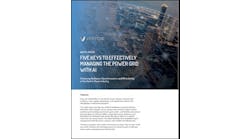Microgrids and distributed energy resources (DERs) can help reduce Pacific Gas & Electric’s (PG&E) diesel use during California fire emergencies, but only if new incentives are implemented and DER integration systems are created.
Microgrids and DERs will be most helpful, at least in the short-term, if paired with other technologies, including diesel or natural gas. They can also help reduce demand in behind the meter applications in high-risk areas.
Those were some of the conclusions from a Sept. 30 gathering, “Diesel Alternatives for PSPS Mitigation Collaborative Workshop,” organized by ADL Ventures, a firm hired by PG&E to bring together numerous stakeholders to discuss how the utility can lower diesel use while keeping the lights on in certain areas during fire emergencies and public safety power shutoffs (PSPS). Participants included regulators, PG&E, microgrid vendors and others.
“PG&E wanted to get all these stakeholders in the room to wrestle with the challenges and suggest some solutions. What came out of the workshop was a deeper and more holistic understanding of how hard this problem is,” said Ben Silton, energy innovation lead, ADL Ventures.
As part of the effort, ADL Ventures prepared a report for PG&E, “An Economic, Technical, and Environmental Analysis of Diesel Alternatives to Mitigating the Impact of Public Safety Power Shutoffs on PG&E Customers,” which it submitted to the California Public Utilities Commission Sept. 25.
Pros and cons of diesel
The report outlines PG&E’s efforts to grapple with fire risks and PSPS by safely energizing certain portions of the grid in fire-prone areas to keep the lights on for as many customers as possible.
While the report identified diesel as the most effective technology in the short term because it can operate 24/7, it costs $182/kW a year plus fuel costs and emits half a pound of particulate emissions per MWh, said the report.
PG&E is looking for diesel alternatives to provide resilience to its customer base at low cost and low environmental impact, the report said.
“PG&E recognizes that diesel fuel is not preferred due to the local and global environmental impacts associated with its combustion. That is why for 2020, PG&E has discussed with its temporary generation vendors about the need to first use hydrogenated vegetable oil (HVO; a form of renewable diesel) as available and feasible and then use conventional diesel, if needed. The vendors have committed to using HVO subject to supply availability and their ability to deliver the fuel,” said Paul Doherty, a PG&E spokesman. He added that the company is committed to working toward cleaner solutions for the temporary generation that may be needed beyond 2020. The workshop was a key part of developing a strategy, he said.
Front-of-meter solutions include temporary microgrids at certain substations.
Earlier this year, PG&E issued a request for offers (RFO) seeking generation that could be installed in fire-prone areas. Given the requirements of the RFO, diesel generators were chosen as the best option in part because they operate 24-7.
We analyzed 15 different technologies in great detail. It became clear that only diesel or natural gas can be a stand alone solution today
“We analyzed 15 different technologies in great detail. It became clear that only diesel or natural gas can be a stand alone solution today. The other solutions, while cleaner, require complementary technology or something else to fill out the picture,” said the report. The technologies analyzed ranged from various coventional energy resources, such as natural gas and solar, to emerging sources, such as hydrogen, renewable natural gas and electric vehicle batteries.
What are the alternatives?
One possibility is to “layer” different technologies, including cleaner generation, renewables and behind the meter solutions, said the report. This can reduce the need for diesel and natural gas generators. But in order to take advantage of these cleaner technologies, investment in communication, controls and grid infrastructure would be required, said the report.
PG&E this year reserved about 450 MW of mobile diesel generation that can be mobilized during PSPS events in load pockets where it’s still safe to energize, downstream from transmission infrastructure, said Silton.
“The idea is to have some form of generation available when fire risk is high,” said Chris Richardson, partner with ADL Ventures.
During the workshop, a participant from PG&E asked vendors to come up with standardized solutions and promises of accountability.
“Stakeholders should come together to provide a single source of accountability where someone can wrap these technologies together so PG&E can count on that solution,” he said. An example might be fuel cells with flywheels, solar and storage and demand response.
“Folks could come up with proposals for how they might provide a wrapped set of solutions for PG&E to evaluate and deploy,” said Richardson. The proposals would have to include information about who would be responsible if the technology didn’t operate as expected.
PG&E’s Doherty said that a goal of the workshop was to co-design clean teams of technology solutions for “various illustrative substations.”
Microgrids for main street
One option examined in the report would be launching temporary microgrids to light up “Main Street,” said the report.
Image courtesy ADL Ventures
In addition to looking at generation, the report and the workshop attendees looked at ways to reduce load during fire emergencies.
“We heard people saying they want to reduce the net load; for every hour we can put solar on a rooftop and add storage, we can reduce what’s required at the substations,” said Richardson. “But what we can’t do is use behind-the-meter assets as grid assets.” That’s due in part to worries that too much solar in load pockets could destabilize the grid.
What’s more, solar doesn’t always perform during fire emergencies because smoke reduces the amount of radiation to the panels.
Another hurdle is the lack of fully functional distributed energy resources management systems to provide for the integration of more DERs.
However, behind the meter solar, storage and other DERs can help reduce the net load of customers.
During the workshop, some participants suggested incentives to get more DERs installed and reduce the load in the high risk areas.
“One could argue that net energy metering is already a strong incentive to residential solar plus storage,” said Richardson. However, some argue that net energy metering shifts costs onto customers who don’t have solar and don’t use net metering.
By Sundry Photography/Shutterstock.com
Forming competitive markets
Pedro Santos, CEO, Andalusian Energy, said that his workshop group looked at the need for creating a competitive market. What’s required, he said, is the utility providing visibility on its needs and evaluation criteria. With this information, companies can organize and submit solutions that address those needs, recognizing that a combination of solutions would best fit the requirements “instead of forcing one technology solution for all.”
The overall PSPS requirement isn’t large enough to warrant new technology development, he noted. If the wildfire-related shutoffs became a national or international issue, that might change.
Incentives for customers with behind-the-meter batteries or other DERs would also be helpful, said the report. The incentives could be offered specifically during the wild-fire related power shutoffs. .
While solar and storage could potentially be installed at substations, a bigger opportunity would be to use distributed resources in parking lots, on rooftops and in garages throughout the load pocket as grid assets, said the report.
Islanding DERs
Another approach would be to encourage customers to island their behind the meter solar and storage during the power shutoffs.
“While these assets may not actively provide flexibility to the grid, they reduce the net load by allowing customers to island without relying as much on the grid during PSPS,” said the report.
Santos described, as a first step, implementing behind the meter resources to lower demand. That could include behind the meter storage and emergency generation.
One option would be a combination of short term storage for a fraction of a day, combined with longer duration — multi-day —chemical storage. Electric and other storage technologies can’t respond economically to multi-day disruptions, he said.
PG&E roadmap
The report and the workshop were designed to help PG&E develop a roadmap for non-diesel solutions.
“Now PG&E needs to think what that longer term strategy should be. Our goal was to give PG&E the ammunition to move forward,” said Richardson.
Join us at Microgrid 2020 Global, a free virtual conference November 17-19, for more discussion about California wildfires and energy resilience. Register today; space limited.








